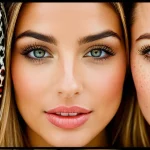The Intersection of UK Women’s Fashion and Personal Identity
Fashion in the UK serves as a dynamic canvas for self-expression and personal identity. Over the decades, UK women’s fashion has not only mirrored historical changes but also fueled personal and societal transformation. The historical context is rich—ranging from the tailored elegance of the early 20th century to the rebellious statements of the 1960s.
Today, UK women’s fashion reflects the nation’s cultural diversity. The blend of global influences is visible in the eclectic mix of styles that cater to individual values and personal identity. For many, clothing choices are a reflection of unique life stories and personal beliefs.
Also to discover : How can UK women make a statement with bold prints and patterns?
Fashion plays a crucial role in shaping self-image and lifestyle choices in the UK. Whether it’s through sustainably-sourced materials or retro-inspired designs, fashion allows women to express who they are. It is more than just clothing; it is an extension of individuality and personal identity, illustrating the ongoing conversation between past traditions and contemporary innovation.
Key Fashion Trends in the UK
UK fashion trends are a vibrant tapestry of styles, continually evolving and adapting. These trends highlight how style influence from diverse cultures can shape contemporary fashion.
Also read : How can UK women find their unique fashion identity?
Traditional Styles and Their Modern Adaptations
Traditional UK fashion styles, known for their classic elegance, are continuously reimagined. Designers incorporate modern adaptations into traditional garments, blending old-world craftsmanship with contemporary aesthetics. Plaid and tweed, for example, persist in popularity but are now seen with fresh cuts and bold color variations. This fusion keeps tradition alive while allowing innovation.
Sustainable Fashion and Ethical Choices
The rise of sustainable fashion significantly influences UK fashion trends, as more consumers demand eco-friendly options. Brands are using eco-conscious materials to create garments that resonate with environmentally aware individuals. The push towards sustainability does not sacrifice style; rather, it encourages creativity in using recycled fabrics and ethical production methods to deliver compelling fashion narratives.
Influence of Streetwear and Casual Culture
Streetwear, heavily influenced by urban culture, plays a pivotal role in UK fashion. This casual culture is celebrated for its adaptability and comfort, often characterized by bold graphics and relaxed fits. Streetwear mirrors regional identities, offering a platform for local talents to showcase their unique perspectives. The rise of streetwear underscores how fashion can be both a form of everyday expression and a statement of individuality.
Cultural Influences on Fashion Choices
Fashion in the UK is deeply intertwined with cultural influences, creating a dynamic tapestry that celebrates multiculturalism. The impact of immigration has introduced vibrant threads of tradition and modernity into the fashion landscape, making it a rich mosaic of cultural expression.
The Impact of Immigration and Multiculturalism
As a hub of diverse cultures, the UK fashion scene exemplifies how cultural influences enrich fashion identity. Immigrants bring unique textiles, designs, and styles from their homelands, integrating and transforming the British fashion palate. This symbiosis fuels creativity, inviting designers to blend traditional elements from around the globe into cohesive collections that speak to a wide audience.
Representation Through Clothing and Accessories
Clothing and accessories serve as a canvas for representing individuality and heritage. Wearing garments like saris, hijabs, or kilts allows individuals to express cultural pride while participating in the broader dialogue of fashion identity. Accessories, from jewellery to handbags, often feature motifs or colours symbolizing a person’s origins, allowing for subtle nods to one’s cultural background.
Personal Stories in Cultural Fashion Narratives
Many women find their identity through the incorporation of cultural elements into their fashion choices. These choices are often reflections of upbringing and personal stories, weaving a narrative that resonates with both self and community. Whether it’s a second-generation immigrant incorporating ancestral prints into modern outfits or a British-born woman embracing global styles, fashion is a potent medium for storytelling and self-expression.
Fashion Icons and Their Impact on Identity
Fashion icons have long shaped the landscape of UK women’s fashion, influencing how personal identity is expressed through clothing. These fashion icons serve as powerful figures in personal branding, offering inspiration through their unique styles and fearless self-expression.
Historical Fashion Figures
Historically, UK fashion has been blessed with numerous iconic figures whose influence persists today. From the timeless elegance of Queen Elizabeth II with her classic coats and hats, to Mary Quant’s revolutionary mini-skirts in the 1960s, these figures have not only defined eras but also set benchmarks for boldness and creativity. Their legacies continue to inspire generations seeking to forge their own style identities.
Modern Influencers and Their Styles
With the advent of social media, modern influencers have become pivotal in shaping contemporary fashion trends. These influencers often merge high-fashion pieces with streetwear to create eclectic and approachable styles. Platforms like Instagram and TikTok allow them to reach global audiences, turning personal branding into an everyday affair. Modern influencers use their platforms to promote authenticity and diversity, encouraging followers to embrace individuality in their style choices.
How to Choose Your Fashion Role Models
In choosing fashion role models, individuals should look for traits that resonate with personal values and ambitions. It’s important not just to emulate styles, but to use these examples as a foundation to build a personal aesthetic that feels true to one’s identity. Attributes such as confidence, authenticity, and creativity can guide individuals in curating a style that reflects personal branding. The key is to draw inspiration without losing sight of individuality.
Practical Tips for Expressing Identity Through Fashion
Fashion is more than just clothing; it’s a medium for self-expression and an avenue to reflect personal identity. Building a wardrobe that mirrors your individuality begins with understanding your own values and lifestyle.
Building a Wardrobe
To start, focus on selecting clothing that aligns with your core beliefs. Consider incorporating sustainable fashion choices if environmental consciousness is important to you. A well-curated wardrobe with ethically-sourced items reflects commitment to these principles.
Mixing and Matching Styles
To truly let your personality shine, experiment with various styles. Mixing vintage pieces with contemporary fashion items can create a unique aesthetic. Try combining sharp, tailored garments with casual, relaxed pieces to find a balance that suits your identity.
Stability in Comfort and Confidence
While style is important, never underestimate the value of comfort. Feeling at ease in your clothing allows confidence to flourish. Choosing fabrics and cuts that enhance comfort can foster a positive self-image. Personal expression becomes effortless when you’re comfortable in your own style.
By integrating these elements into your daily fashion choices, you not only enhance your wardrobe but also nurture a truer sense of self.
Expert Opinions and Case Studies
Exploring the intersection of personal anecdotes and designer insights offers profound insights into the fashion world. By uncovering personal journeys and community experiences, we can appreciate how fashion serves as a vital means of self-expression and identity.
Interviews with Fashion Designers
Renowned designers often infuse their collections with personal philosophies, reflecting both cultural influences and modern aesthetics. Through insightful interviews, designers share how fashion serves as a narrative vehicle, weaving in their inspirations, values, and creative processes. This exchange not only represents an artistic vision but also offers guidance for those looking to use fashion as a canvas for self-expression.
Case Studies on Individual Fashion Journeys
Personal anecdotes about individual fashion journeys reveal how deeply ingrained fashion is in personal identity. These stories highlight how various women navigate trends and traditions to forge unique styles that reflect both personal and cultural backgrounds. By examining these journeys, we gain an understanding of how fashion choices echo deeper self-exploration and personal growth.
Community and Shared Fashion Experiences
Community gatherings and fashion events play a pivotal role in shaping and celebrating shared fashion identities. These occasions offer a platform for diverse voices to express themselves, fostering a sense of belonging through shared experiences. By engaging in these communal settings, individuals connect over fashion, enhancing their understanding of personal and collective identity within the broader fashion narrative.






